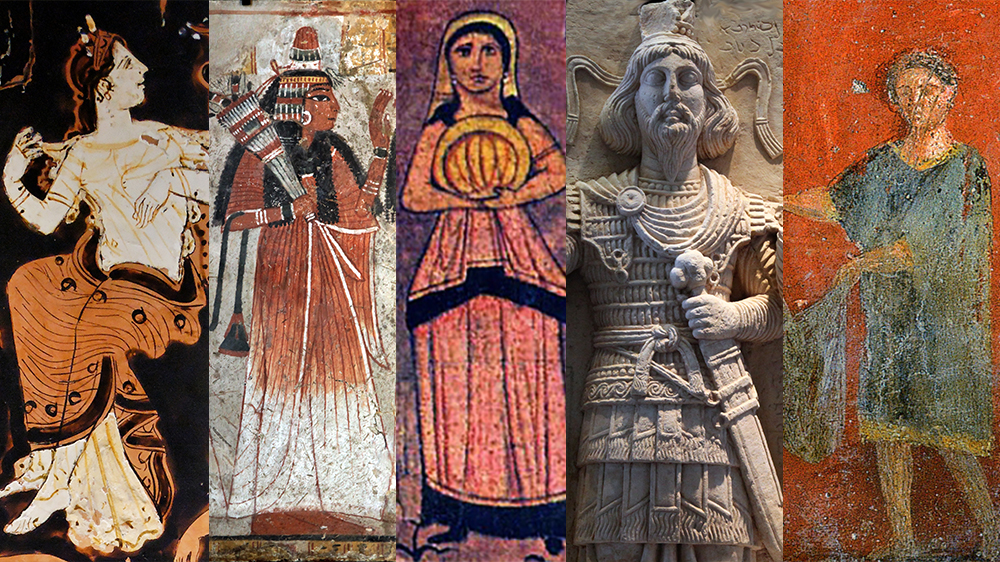About the lecture
The Phoenician and Punic terracotta representations of musicians are mostly of female figures, richly dressed and adorned with necklaces and pendants. Playing an instrument, as well as dancing, with such attire would have enriched the soundscapes of the ritual performances in which they took place. Dress, attire and adornment, therefore, are not static, but active elements configuring the whole performance. In this lecture we will present a selection of these terracotta figurines from the western Mediterranean (Iberia, Ibiza, and Carthage, seventh-second centuries BCE) to analyse these elements and their implications in the musical and dance performances. We will argue that playing music was an empowering activity for certain Phoenician and Punic women, and that dress and adornment where key.
About Dr. Garcia-Ventura

Agnès Garcia-Ventura received her Ph.D. in History by the Universitat Pompeu Fabra in Barcelona in 2012. Since then she has been awarded several postdoc fellowships, in competitive calls, to work at the University of Heidelberg (Germany), at the University of Rome, ‘La Sapienza’ (Italy), and at the University of Barcelona (Spain). Currently she is “Ramón y Cajal” fellow at the University Autònoma of Barcelona (Spain). Her main areas of interest are gender studies (especially their application to Assyriology), historiography of ancient Near Eastern studies in Spain, the organization of work in Mesopotamia, and ancient musical performance (in both Mesopotamia and the Phoenician and Punic contexts). E-mail: agnes.garcia.ventura@uab.cat
About Dr. López-Bertran

Mireia López-Bertran is Associate professor at Departament of Art History of the Universitat de Valencia, Spain. She received her PhD degree in History from the Universitat Pompeu Fabra (Barcelona, Spain) in 2007. Between 2010-2012, she was postdoctoral researcher of the Spanish Ministry of Education and Culture-FECYT and she worked as an Honorary Research Fellow at the Archaeology Unit of the University of Glasgow. She was appointed Beatriu de Pinós/Marie Curie Postdoctoral fellow at the Universitat Pompeu Fabra in Barcelona between 2014 and 2016. She specialises in the Phoenician-Punic archaeology, with research interests in iconography, ancient Mediterranean art, embodiment, rituals and gender. E-mail: Mireia.Lopez@uv.es
Digital event - how to participate
The seminar will be held digitally. If you wish to attend a lecture, you need to register in advance.
A zoom link will be sent to you before the event. You can download Zoom or use your browser: https://zoom.us/download
Suggestions for further Reading
-
Fariselli, Anna Chiara, 2010: Danze “regali” e danze “popolari” fra Levante fenicio e Occidente punico. In Paola Dessì (ed.): Per una storia dei popoli senza note. Bologna, 13-28.
-
Fariselli, Anna Chiara, 2017: Le « savoir musical » phénicien et punique dans la Méditérranée préromaine à travers les sources écrites. In Mireille Corbiere / Gilles Sauron (eds.): Langages et communication: écrits, images, sons. Actes des congrès nationaux des sociétés historiques et scientifiques (édition électronique), 237-246.
-
Garcia-Ventura, Agnès / López-Bertran, Mireia, 2013: Music and Death: Razors, Stelae and Divinities in the Punic Mediterranean. In Raquel. Jiménez / Rupert Till / Mark Howell (eds.): Music and Ritual: Bridging Material and Living Cultures. Berlin, 93-115.
-
López-Bertran, Mireia / Garcia-Ventura, Agnès, 2012: Music, Gender and Rituals in Ancient Mediterranean: Revisiting the Punic Evidence. World Archaeology 44, 3, 393-408.
-
López-Bertran, Mireia / Garcia-Ventura, Agnès, 2016: Performing Music in Punic Carthage: a Coroplastic Approach. In Angela Bellia / Clemente Marconi (eds.): Musicians in Ancient Coroplastic Art. Iconography, Ritual Contexts, and Functions. Pisa / Roma, 45-56.
About Ancient Attire
A Digital Lecture Series on Dress, Adornment and Vestimentary Codes in the Ancient Mediterranean World
The aim of this series is to investigate vestimentary codes in ancient cultures, and to explore how these concepts relate to gender, hierarchy and power.
Seven excellent international researchers, experts on the material cultures and texts of the ancient Mediterranean, will present a 30-minute lecture, followed by amble time for questions and discussion.
We are interested in mapping dress and adornment as broadly as possible and therefore we encourage our speakers to consider vestimentary codes from a multi-sensorial perspective and to give thought to both touch, smell, taste, hearing and vision.
Ancient Attire Programme - Fall 2022
- Friday August 26 at 3pm (Oslo): Dr. Rosalind Janssen: “Unpacking Tutankhamun’s Wardrobe”
- Friday September 16 at 3pm (Oslo): Dr. Laura Quick: “Divine Dress, Divinization and Dethronement in the Hebrew Bible”
- Friday October 21 at 3pm (Oslo): Dr. Søren Lorenzen: “The High Priest and his Glorious Camouflage”
- Friday November 11 at 3pm (Oslo): Dr. Mary Harlow: “Female Dress at Rome: Getting it Right”
- Friday December 2 at 3pm (Oslo): Dr. Agnès Garcia-Ventura and Dr. Mireia López-Bertran: “Dressed to sound? An approach to dress and attire of female musicians in Phoenician and Punic contexts”
- Friday December 16 at 3pm (Oslo): Dr. Salvatore Gaspa: “Dress, Adornment and the Material Language of Power: Royal Textiles in Assyria”
Organizer
The lecture series is organized by Professor Anne Katrine de Hemmer Gudme and hosted by The Faculty of Theology at the University of Oslo and the Faculty’s research group Biblical Texts, Cultures and Receptions.
